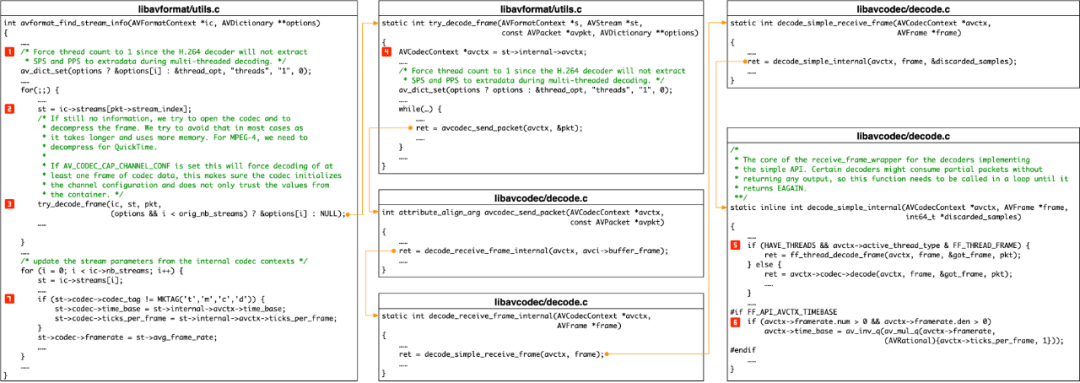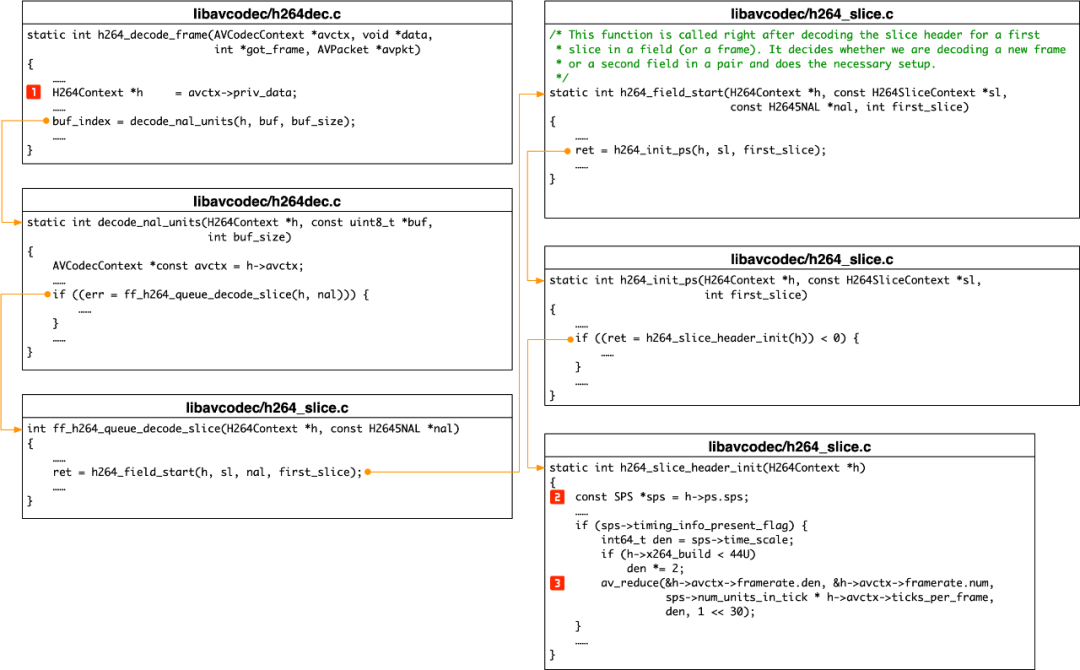-
为什么OpenCV计算的帧率是错误的?
 点击上方“LiveVideoStack”关注我们
点击上方“LiveVideoStack”关注我们
▲扫描图中二维码或点击阅读原文▲
了解音视频技术大会更多信息
作者:王伟
编辑:Alex
引 言
我们有一个平台来周期性地对线上的直播流数据进行某些检测,例如黑/白屏检测、静态画面检测……在检测中,我们会根据提取到的直播流的帧率来预估要计算的帧数量,例如,如果要检测5s的直播流,而该直播流的帧率为20fps,需要计算的帧数量则为100。忽然有一天,我们发现,平台开始大面积的超时,之前只需要2s就能完成的计算,现在却需要30+分钟。查了之后,我们发现,之所以计算超时是因为OpenCV计算的帧率为2000,从而导致需要计算的帧数量从之前的100变为了10000,进而引起了计算超时。
1
OpenCV 如何计算帧率
这个问题的具体描述可以参见 OpenCV Issues 21006[1]。该问题的模拟直播流片段test.ts可以点击链接下载:
https://pan.baidu.com/share/init?surl=RY0Zk5C_DOEwTXYe2SLFEg,下载提取码为x87m。
如果用如下的代码获取test.ts的fps,
- const double FPS = cap.get(cv::CAP_PROP_FPS);
- std::cout << "fps: " << FPS << std::endl;
可以得到:
$ fps: 2000用ffprobe对视频进行分析,可以得到:
- codec_name=h264
- r_frame_rate=30/1
- avg_frame_rate=0/0
- ……
从 opencv/modules/videoio/src/cap_ffmpeg_impl.hpp[2]中,我们发现fps由
CvCapture_FFMPEG::get计算而来,其计算逻辑如下:- double fps = r2d(ic->streams[video_stream]->avg_frame_rate);
- if (fps < eps_zero) {
- fps = 1.0 / r2d(ic->streams[video_stream]->codec->time_base);
- }
2
为什么OpenCV得到的帧率是错的
利用test_time_base.cpp[3],我们可以得到:
- time_base: 1/2000
- framerate: 0/0
- avg_framerate: 0/0
- r2d(ic->streams[video_stream]->avg_frame_rate) = 0
所以OpenCV采用了:
1.0 / r2d(ic->streams[video_stream]->codec->time_base)来计算该视频的fps。而此处的time_base = 1/2000,因此,最终得到的fps是2000。
也就是说,AVStream->codec->time_base的值导致了OpenCV得到一个看起来是错误的fps。那么,AVStream->codec->time_base为什么是这个值呢?FFmpeg是怎么计算这个字段的呢?
3
FFmpeg 如何计算
AVCodecContext.time_base
AVStream->codec->time_base是AVCodecContext中定义的 time_base字段,根据libavcodec/avcodec.h[4] 中的定义可知,对于解码而言,time_base已经被废弃,需要使用framerate来替换 time_base。并且,对于固定帧率而言,time_base = 1/framerate,但并非总是如此。
利用H264Naked[5]对test.ts对应的H.264码流进行分析,我们得到SPS.Vui信息:
- timing_info_present_flag :1
- num_units_in_tick :1
- time_scale :2000
- fixed_frame_rate_flag :0
从中可以看到,test.ts是非固定帧率视频。从test_time_base.cpp[3]的结果看,test.ts视频中,framerate = 0/0,而time_base = 1/2000。
难道,对于非固定帧率视频而言,time_base和framerate之间没有关联?如果存在关联,那又是怎样的运算才能产生这种结果?这个 time_base究竟是怎么计算的呢?究竟和framerate有没有关系呢?一连串的问题随之而来……
源码面前,了无秘密。接下来,带着这个问题,我们来一起分析一下FFmpeg究竟是如何处理time_base的。
3.1 avformat_find_stream_info
在 FFmpeg中,
avformat_find_stream_info()对ic->streams[video_stream]->codec进行初始化,因此我们可以从avformat_find_stream_info()开始分析。从 libavformat/avformat.h[6]中,可以得知
avformat_open_input()会打开视频流,从中读取相关的信息,然后存储在AVFormatContext中,但是有时候,此处获取的信息并不完整,因此需要调用avformat_find_stream_info()来获取更多的信息。需要注意的是:
avformat_find_stream_info()会尝试通过解码部分视频帧来获取需要的信息。- /**
- * Read packets of a media file to get stream information. This
- * is useful for file formats with no headers such as MPEG. This
- * function also computes the real framerate in case of MPEG-2 repeat
- * frame mode.
- * The logical file position is not changed by this function;
- * examined packets may be buffered for later processing.
- *
- * @param ic media file handle
- * @param options If non-NULL, an ic.nb_streams long array of pointers to
- * dictionaries, where i-th member contains options for
- * codec corresponding to i-th stream.
- * On return each dictionary will be filled with options that
- * were not found.
- * @return >=0 if OK, AVERROR_xxx on error
- *
- * @note this function isn't guaranteed to open all the codecs, so
- * options being non-empty at return is a perfectly normal behavior.
- *
- * @todo Let the user decide somehow what information is needed so that
- * we do not waste time getting stuff the user does not need.
- */
- int avformat_find_stream_info(AVFormatContext*ic, AVDictionary **options);
avformat_find_stream_info()的整体逻辑大致如下图所示,其中特别需要关注图中所示的 7 个步骤:
3.2 avformat_find_stream_info()的重要步骤说明
STEP 1 设置线程数,避免H.264多线程解码时没有把SPS/PPS信息提取到extradata。
STEP 2 设置
AVStream *st,st会在后续的函数调用中一直透传到try_decode_frame()。STEP 3 比较简单,这里不再赘述。
STEP 4 设置
AVCodecContext *avctx为透传的st->internal->avctx,在后续的解码函数调用中,一直透传的就是这个avctx,因此,从这里开始的执行流程,FFmpeg使用的全部都是st->internal->avctx,而不是st->codec,这里要特别的注意。此处同时会设置解码的线程数,其目的和STEP 1是一致的。STEP 5 因为之前设置了解码线程数为1,所以此处会调用
ret = avctx->codec->decode(avctx, frame, &got_frame, pkt)来解码并计算avctx->framerate。注意,此处的avctx实际上是透传而来的st->internal->avctx。计算 framerate的逻辑会在如何计算framerate部分介绍。
STEP 6 根据解码器得到的framerate信息来计算 avctx->time_base,注意此处实际上是st->internal->avctx->time_base。根据 如何计算framerate可知,此处framerate = {1000, 1}。根据 AVCodecContext.ticks_per_frame的介绍可知,ticks_per_frame = 2。因此,此处avctx->time_base = {1, 2000}:
avctx->time_base = av_inv_q(av_mul_q({1000, 1}, {2, 1})) = {1, 2000}STEP 7 这一步可谓是“瞒天过海,明修栈道暗度陈仓”。这一步为了解决API的前向兼容,做了一个替换,把st->internal->avctx->time_base 赋值给了st->codec->time_base,而把st->avg_frame_rate 赋值给了 st->codec->framerate。因此:
- st->codec->time_base = {1, 2000}
- st->codec->framerate = {0, 0}
st->codec->time_base 的计算和 st->codec->framerate 之间没有任何关系,而是和 st->internal->avctx->framerate 有关。究其本质,是和sps.time_scale,sps.num_units_in_tick有关。
- st->internal->avctx->time_base.num =
- sps->num_units_in_tick *
- st->internal->avctx->ticks_per_frame
- st->internal->avctx->time_base.den = sps->time_scale *
- st->internal->avctx->ticks_per_frame;
- st->internal->avctx->time_base = {sps->num_units_in_tick,
- sps->time_scale}
3.3 internal->avctx->time_base & internal->framerate
所以实际上,internal->avctx->time_base为:
- avctx->time_base = sps->num_units_in_tick /
- sps->time_scale
而internal->avctx->framerate则是:
- avctx->framerate = sps->time_scale /
- (sps->num_units_in_tick * avctx->ticks_per_frame)
因此,对于 H.264 码流而言,time_base = 1 / (2 * framerate),而不是1 / framerate。
这也就是为什么
libavcodec/avcodec.h[4] 中说:
- * This often, but not always is the inverse of the frame rate or field rate
- * for video.
从如上的分析可以知道:
avctx->framerate = 1 / (avctx->time_base * avctx->ticks_per_frame)因此,当st->avg_frame_rate = 0 时,OpenCV计算fps的逻辑是错误的。
在H.265中,ticks_per_frame = 1,因此对于H.265的编码,OpenCV是没有这个问题的。可以使用Zond 265 [7]工具来分析一个 H.265的视频码流,然后对照OpenCV以及FFmpeg的结果来验证。
同时,正是如上所示的STEP 7中的移花接木导致了 test_time_base.cpp[3] 的结果:
- st->codec->framerate: 0/0
- st->codec->time_base: 1/2000
3.4 ff_h264_decoder
libavcodec/decode.c [8]中的
decode_simple_internal()会调用对应的解码器来进行解码(STEP 5)。而正如前所示,test.ts为H.264 编码的视频流,因此此处会调用 H.264 解码器来进行解码。在FFmpeg中,H.264解码器位于 libavcodec/h264dec.c[9] 中定义的const AVCodec ff_h264_decoder。- const AVCodec ff_h264_decoder = {
- .name = "h264",
- .type = AVMEDIA_TYPE_VIDEO,
- .id = AV_CODEC_ID_H264,
- .priv_data_size = sizeof(H264Context),
- .init = h264_decode_init,
- .close = h264_decode_end,
- .decode = h264_decode_frame,
- ......
- };
在上文图中的STEP 5中,
ret = avctx->codec->decode(avctx, frame, &got_frame, pkt);实际调用的就是:
ff_h264_decoder->h264_decode_frame(avctx, frame, &got_frame, pkt);而此处的avctx也就是
try_decode_frame()中透传下来的st->internal->avctx,即上文图中的STEP 4。3.5 h264_decode_frame
h264_decode_frame()的整体逻辑如下图所示:
3.6 AVCodecContext.ticks_per_frame
后面会用到ticks_per_frame来计算framerate。在STEP 6中计算 time_base的时候也用到了该值。因此,有必要做一下特殊说明。在H.264解码器中,ticks_per_frame=2,其具体的取值可以从如下几处得知:
libavcodec/avcodec.h [4]中的字段说明:
- /**
- * For some codecs, the time base is closer to the field rate than the frame rate.
- * Most notably, H.264 and MPEG-2 specify time_base as half of frame duration
- * if no telecine is used ...
- *
- * Set to time_base ticks per frame. Default 1, e.g., H.264/MPEG-2 set it to 2.
- */
- int ticks_per_frame;
libavcodec/h264dec.c [9]中的
h264_decode_init():
avctx->ticks_per_frame = 2;4
如何计算framerate
STEP 1 根据整体的计算流程可知,此处的h实际上就是
avformat_find_stream_info()中的st->internal->avctx->priv_data。h会一直透传到之后的所有流程,这个务必要注意。
STEP 2 此处会首先获取到sps的相关信息,以备后续的计算使用,我们可以再次看一下test.ts sps[10] 的相关信息。
- timing_info_present_flag :1
- num_units_in_tick :1
- time_scale :2000
- fixed_frame_rate_flag :0
STEP 3 根据sps的相关信息计算framerate,在上文的STEP 6中计算 time_base用到的framerate就是在此处计算的。因为 timing_info_present_flag = 1,因此会执行计算
framerate的逻辑:- avctx->framerate.den = sps->num_units_in_tick * h->avctx->ticks_per_frame = 1 * 2 = 2
- avctx->framerate.num = sps->time_scale = 2000
- avctx->framerate = (AVRational){1000, 1}
因此,
st->internal->avctx->framerate = {1000, 1}但是,因为avctx->time_base={1,2000},所以OpenCV计算出来的帧率结果为2000。导致这种不一致的原因在于,OpenCV在使用codec->time_base计算帧率的时候没有考虑ticks_per_frame。因此,对于OpenCV而言,正确的计算帧率的方式应该为:
- double fps = r2d(ic->streams[video_stream]->avg_frame_rate);
- if (fps < eps_zero) {
- fps = 1.0 / r2d(ic->streams[video_stream]->codec->time_base * ic->streams[video_stream]->codec->ticks_per_frame);
- }
结 论
通过上面的分析我们可以知道:
FFmpeg在计算
AVCodecContex中的framerate和time_base的时候,会用到:o sps.time_scale
o sps.num_units_in_tick
o AVCodecContex.ticks_per_frame
在 FFmpeg 中,framerate和time_base的关系为:
o framerate = 1 / (time_base * ticks_per_frame)
o time_base = 1 / (framerate * ticks_per_frame)
对于非 H.264/MPEG-2,
ticks_per_frame=1,因此framerate和time_base是互为倒数的关系。而对于H.264/MPEG-2 而言,ticks_per_frame=2,因此,此时二者并非是互为倒数的关系。因而,FFmpeg 中才说,framerate和time_base通常是互为倒数的关系,但并非总是如此。
在OpenCV中,对于H.264/MPEG-2视频而言,当
AVStream.avg_frame_rate=0时,其计算fps的逻辑存在BUG。
因为在解码时,
AVCodecContex.time_base已经废弃,同时 AVStream.avctx也已经废弃,而
avformat_find_stream_info()中为了兼容老的API,因此会利用 AVStream.internal.avctx和其他的信息来设置AVStream.avctx。而AVStream.avctx.time_base取自AVStream.internal.avctx,AVStream.avctx.framerate 则取自 AVStream.framerate。
注释:
[1] https://github.com/opencv/opencv/issues/21006
[2] https://github.com/opencv/opencv/blob/4.x/modules/videoio/src/cap_FFmpeg_impl.hpp
[3] https://github.com/wangwei1237/wangwei1237.github.io_src/blob/master/source/_posts/Why-OpenCV-Get-the-Wrong-FPS/test_time_base.cpp
[4]https://github.com/FFmpeg/FFmpeg/blob/master/libavcodec/avcodec.h
[5] https://github.com/shi-yan/H264Naked
[6] https://github.com/FFmpeg/FFmpeg/blob/master/libavformat/avformat.h
[7] https://www.dektec.com/products/applications/Zond/
[8]https://github.com/FFmpeg/FFmpeg/blob/master/libavcodec/decode.c
[9]https://github.com/FFmpeg/FFmpeg/blob/master/libavcodec/h264dec.c
[10] https://wangwei1237.github.io/2021/11/26/Why-OpenCV-Get-the-Wrong-FPS/#sps
作者简介:
王伟,17哥,百度资深测试工程师。百度视频质量评测技术负责人,在解决视频质量评测的标准化、置信度方面有丰富的实践经验,搭建了百度首个体系化的视频质量评测服务平台,并服务于多个视频业务。

喜欢我们的内容就点个“在看”吧!

-
相关阅读:
LiveMedia视频中间件如何与第三方系统实现事件录像关联
SpringCloud(七) - 微信支付
如何在本地创建一个贪吃蛇小游戏node.js服务并实现无公网IP远程游玩
【MySQL】19-MySQL中如何创建数据库和管理数据库
彰显强大技术实力,微信视觉团队斩获CVPR 2023 Video Similarity Challenge双赛道冠军
C++语法基础知识面经汇总
DC36V 3A降压芯片FP6150BXR中文说明,附常规问题,布板说明
深度剖析js闭包
Java的异常类Exception
《Linux高性能服务器编程》--高级I/O函数
- 原文地址:https://blog.csdn.net/vn9PLgZvnPs1522s82g/article/details/125454222
